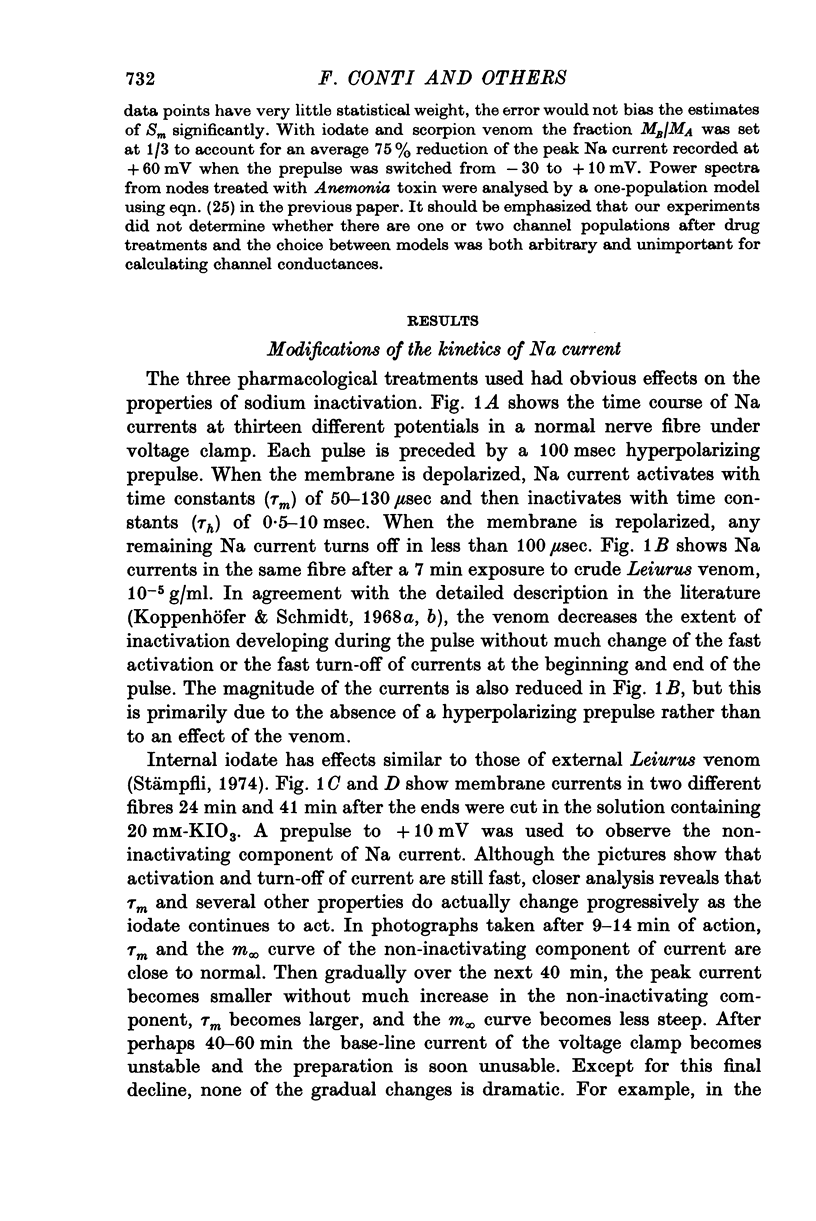Abstract
1. Na current fluctuations in nodes of Ranvier were measured under voltage clamp conditions as described in the preceding paper (Conti, Hille, Neumcke, Nonner & Stämpfli, 1976) and analysed in terms of power spectral density calculated for frequencies between 30 Hz and 5 kHz. 2. External (10(-5) g/ml.) Leiurus scorpion venom or Anemonia Toxin II (3 X 10(-5) g/ml.) or internal 20 mM iodate were applied in order to remove or slow down inactivation in part of the Na channels. The treatment increased the steady-state Na current during the noise measurement one-to eight fold over that in normal fibres. 3. Noise spectra were interpreted as the sum of 1/f noise and noise SNa(f) due to all-or-none, open-close transitions of single Na channels. The drug effects on the inactivation could be accounted for either by assuming two populations of channels, one with and one without inactivation, or by postulating a single population with modified inactivation characteristics. 4. Except for an increase in amplitude, the fluctuation spectra SNa(f) were similar to the ones in normal nodes. Again, the time constants taum obtained from the fit of the spectra agreed within a factor of 2 with the values of taum found in the macroscopic Na currents. 5. From the fluctuation spectra, single Na channel conductances gamma of 5-4 +/- 0-4 pS (iodate), 6-7 +/- 0-5 pS (Leiurus) and 7-0 +/- 0-6 pS (Anemonia) were calculated. The value of gamma was not significantly voltage dependent. 6. Our observations indicate that inactivation of Na channels can be modified with at most small effects on the microscopic properties of the activation process and on the conductance of the open channel. They suggest that the h mechanism normally produces all-or-none, open-close changes of conductance.
Full text
PDF













Selected References
These references are in PubMed. This may not be the complete list of references from this article.
- Almers W., Levinson S. R. Tetrodotoxin binding to normal depolarized frog muscle and the conductance of a single sodium channel. J Physiol. 1975 May;247(2):483–509. doi: 10.1113/jphysiol.1975.sp010943. [DOI] [PMC free article] [PubMed] [Google Scholar]
- Armstrong C. M., Bezanilla F., Rojas E. Destruction of sodium conductance inactivation in squid axons perfused with pronase. J Gen Physiol. 1973 Oct;62(4):375–391. doi: 10.1085/jgp.62.4.375. [DOI] [PMC free article] [PubMed] [Google Scholar]
- Béress L., Béress R., Wunderer G. Isolation and characterisation of three polypeptides with neurotoxic activity from Anemonia sulcata. FEBS Lett. 1975 Feb 15;50(3):311–314. doi: 10.1016/0014-5793(75)80517-5. [DOI] [PubMed] [Google Scholar]
- Conti F., De Felice L. J., Wanke E. Potassium and sodium ion current noise in the membrane of the squid giant axon. J Physiol. 1975 Jun;248(1):45–82. doi: 10.1113/jphysiol.1975.sp010962. [DOI] [PMC free article] [PubMed] [Google Scholar]
- Conti F., Hille B., Neumcke B., Nonner W., Stämpfli R. Measurement of the conductance of the sodium channel from current fluctuations at the node of Ranvier. J Physiol. 1976 Nov;262(3):699–727. doi: 10.1113/jphysiol.1976.sp011616. [DOI] [PMC free article] [PubMed] [Google Scholar]
- HODGKIN A. L., HUXLEY A. F. A quantitative description of membrane current and its application to conduction and excitation in nerve. J Physiol. 1952 Aug;117(4):500–544. doi: 10.1113/jphysiol.1952.sp004764. [DOI] [PMC free article] [PubMed] [Google Scholar]
- Hille B., Campbell D. T. An improved vaseline gap voltage clamp for skeletal muscle fibers. J Gen Physiol. 1976 Mar;67(3):265–293. doi: 10.1085/jgp.67.3.265. [DOI] [PMC free article] [PubMed] [Google Scholar]
- Keynes R. D., Bezanilla F., Taylor R. E., Rojas E. The rate of action of tetrodotoxin on sodium conductance in the squid giant axon. Philos Trans R Soc Lond B Biol Sci. 1975 Jun 10;270(908):365–375. doi: 10.1098/rstb.1975.0016. [DOI] [PubMed] [Google Scholar]
- Keynes R. D., Rojas E. Kinetics and steady-state properties of the charged system controlling sodium conductance in the squid giant axon. J Physiol. 1974 Jun;239(2):393–434. doi: 10.1113/jphysiol.1974.sp010575. [DOI] [PMC free article] [PubMed] [Google Scholar]
- Koppenhöfer E., Schmidt H. Die Wirkung von Skorpiongift auf die Ionenströme des Ranvierschen Schnürrings. I. Die Permeabilitäten PNa und PK. Pflugers Arch. 1968;303(2):133–149. doi: 10.1007/BF00592631. [DOI] [PubMed] [Google Scholar]
- Koppenhöfer E., Schmidt H. Die Wirkung von Skorpiongift auf die Ionenströme des Ranvierschen Schnürrings. II. Unvollständiage Natrium-Inaktivierung. Pflugers Arch. 1968;303(2):150–161. doi: 10.1007/BF00592632. [DOI] [PubMed] [Google Scholar]
- Levinson S. R., Meves H. The binding of tritiated tetrodotoxin to squid giant axons. Philos Trans R Soc Lond B Biol Sci. 1975 Jun 10;270(908):349–352. doi: 10.1098/rstb.1975.0014. [DOI] [PubMed] [Google Scholar]
- Narahashi T., Shapiro B. I., Deguchi T., Scuka M., Wang C. M. Effects of scorpion venom on squid axon membranes. Am J Physiol. 1972 Apr;222(4):850–857. doi: 10.1152/ajplegacy.1972.222.4.850. [DOI] [PubMed] [Google Scholar]
- Nonner W., Rojas E., Stämpfli R. Gating currents in the node of Ranvier: voltage and time dependence. Philos Trans R Soc Lond B Biol Sci. 1975 Jun 10;270(908):483–492. doi: 10.1098/rstb.1975.0024. [DOI] [PubMed] [Google Scholar]
- Rathmayer W., Jessen B. Effect of toxins of sea anemones on neuromuscular transmission. Naturwissenschaften. 1975 Nov;62(11):538–539. doi: 10.1007/BF00609079. [DOI] [PubMed] [Google Scholar]
- Rochat H., Rochat C., Kupeyan C., Miranda F., Lissitzky S., Edman P. Scorpion neurotoxins: A family of homologous proteins. FEBS Lett. 1970 Oct;10(5):349–351. doi: 10.1016/0014-5793(70)80470-7. [DOI] [PubMed] [Google Scholar]
- Stämpfli R. Intraaxonal iodate inhibits sodium inactivation. Experientia. 1974 May 15;30(5):505–508. doi: 10.1007/BF01926319. [DOI] [PubMed] [Google Scholar]
- van den Berg R. J., de Goede J., Verveen A. A. Conductance fluctuations in Ranvier nodes. Pflugers Arch. 1975 Oct 16;360(1):17–23. doi: 10.1007/BF00584323. [DOI] [PubMed] [Google Scholar]


